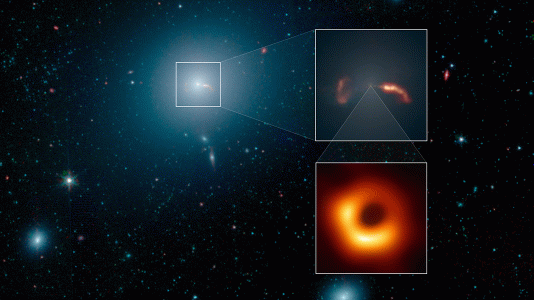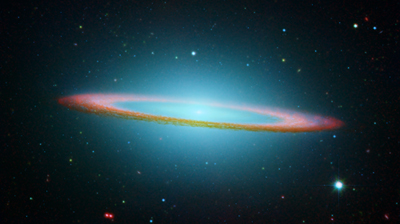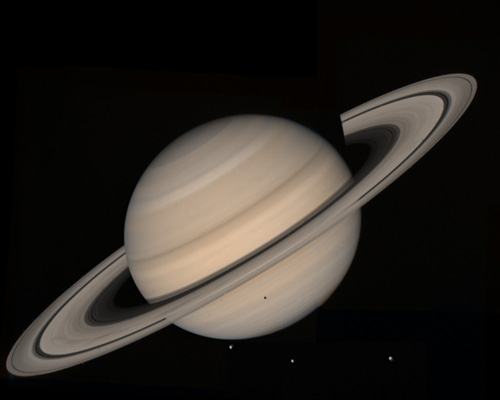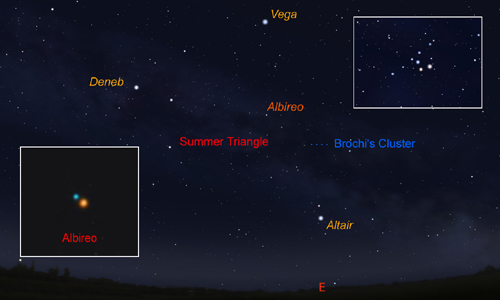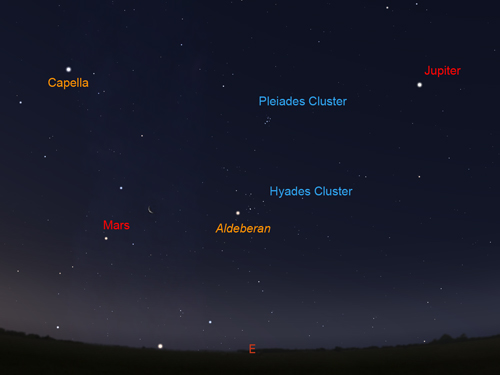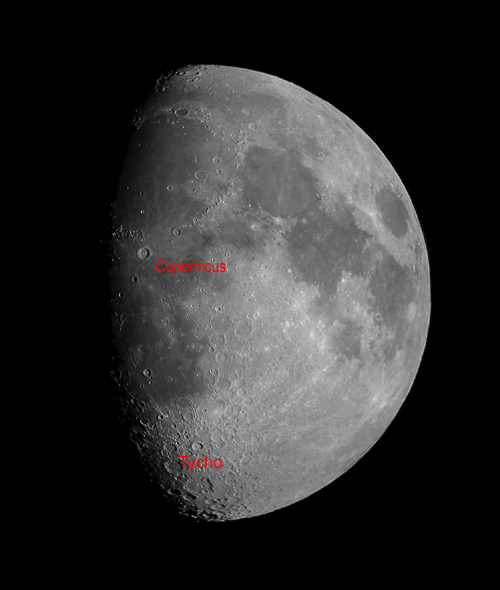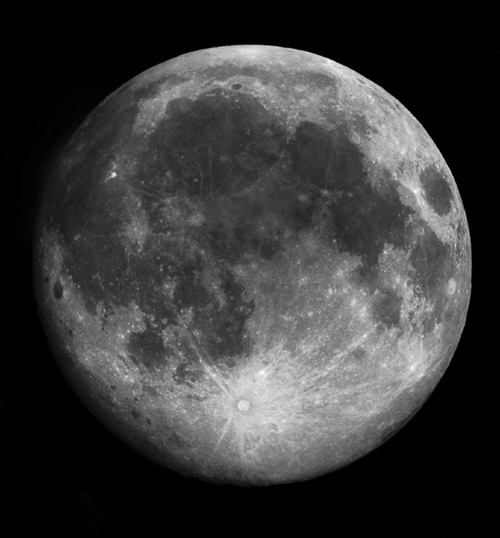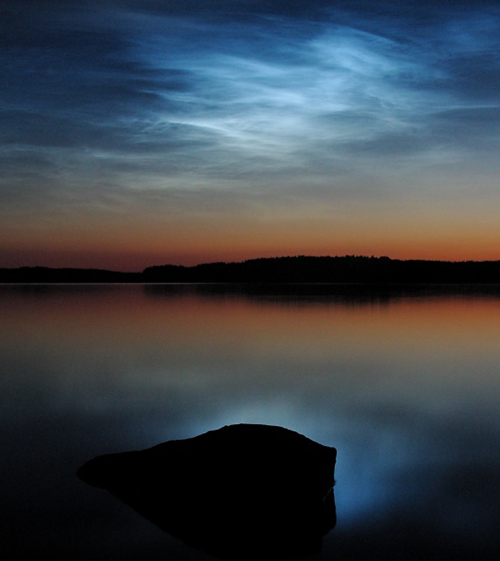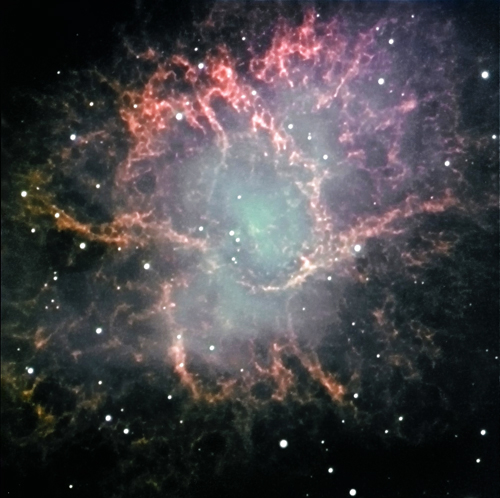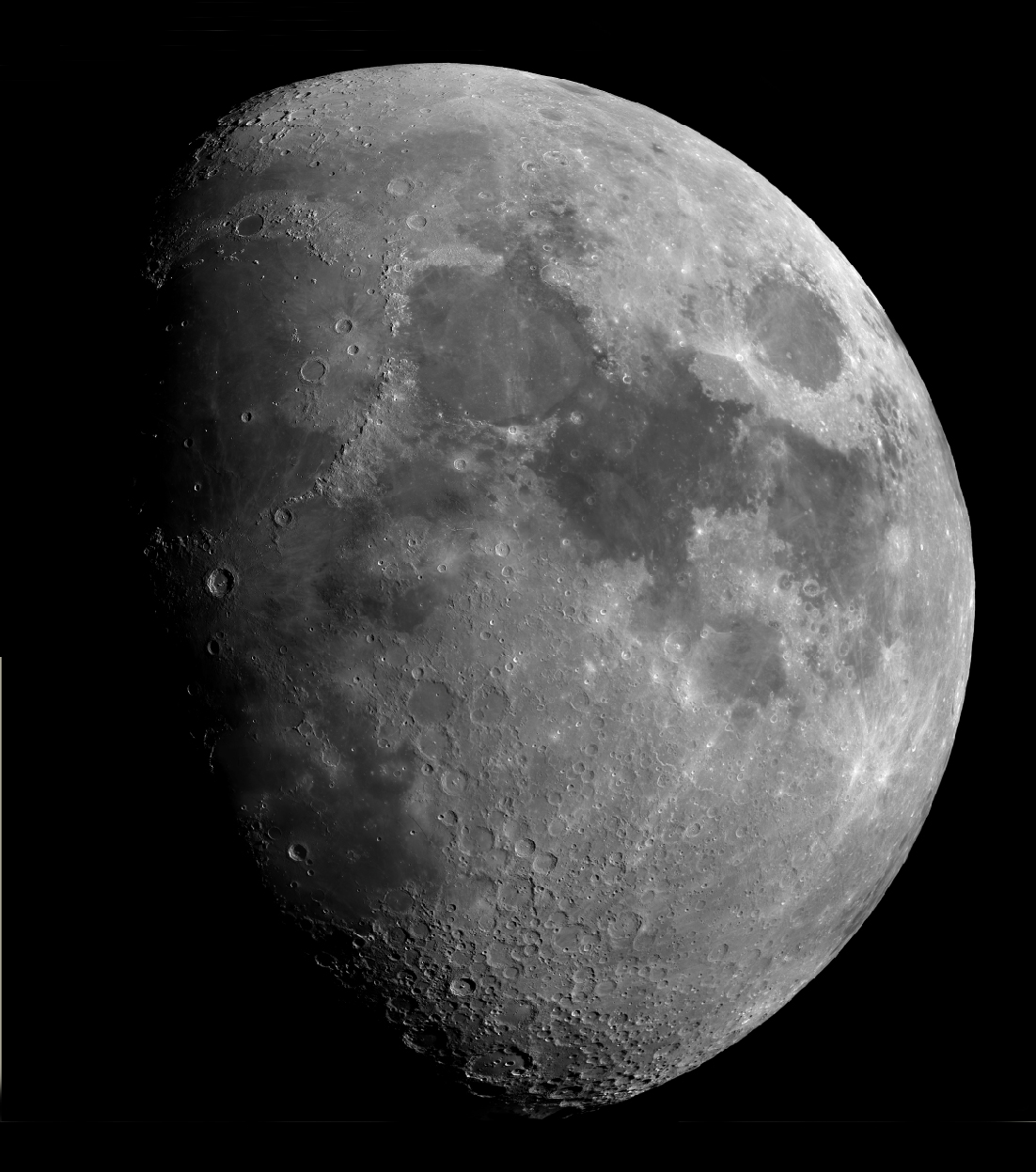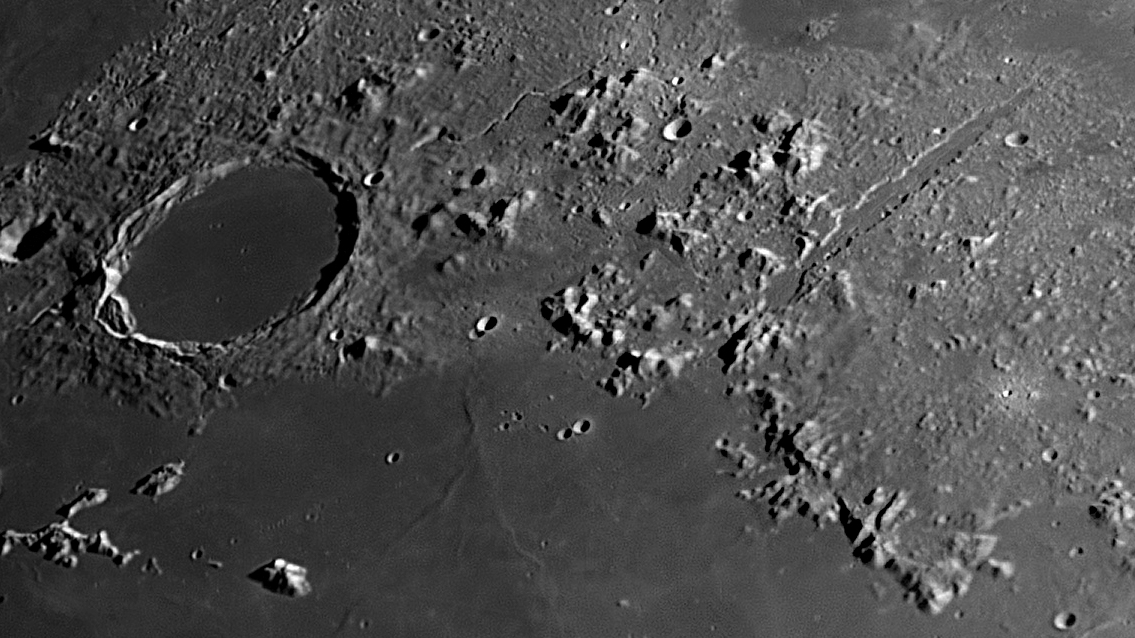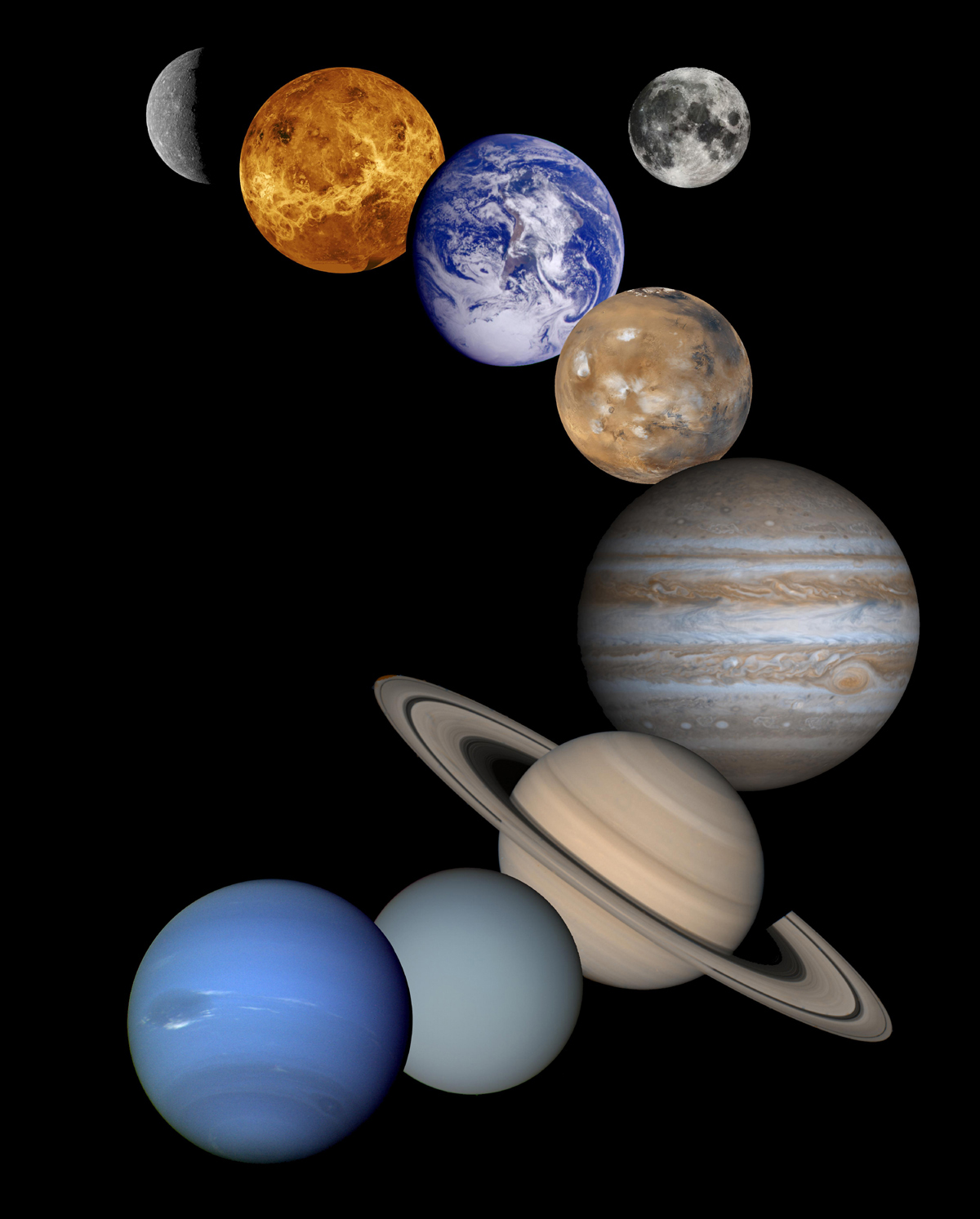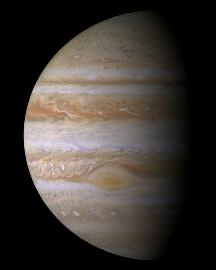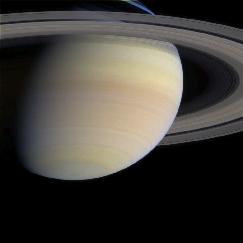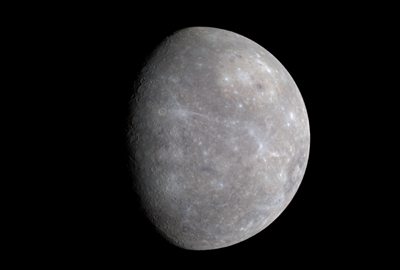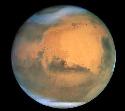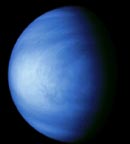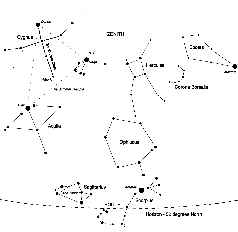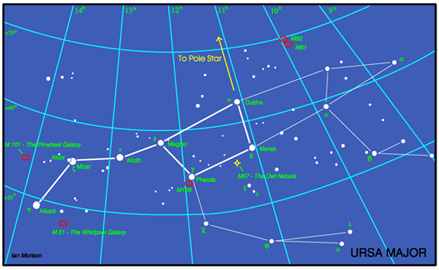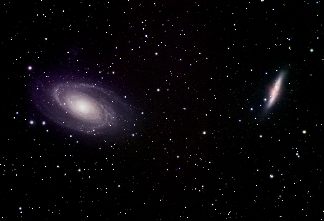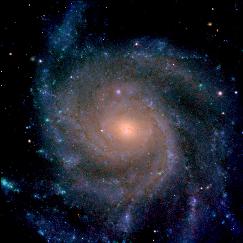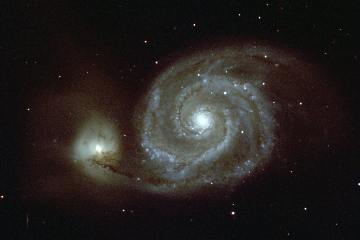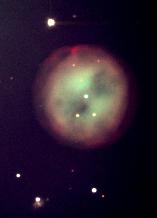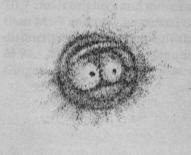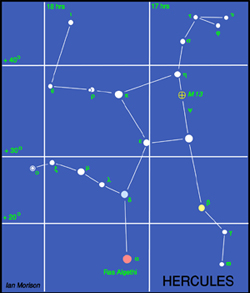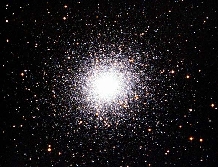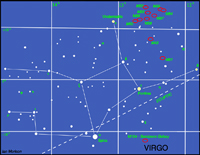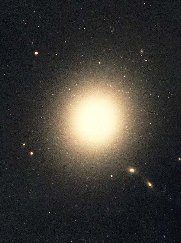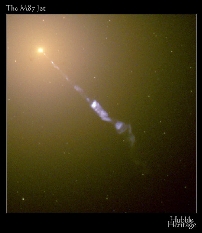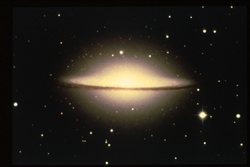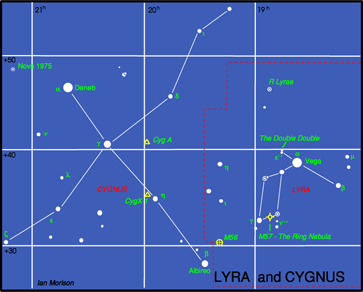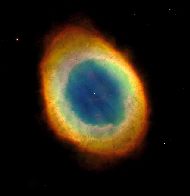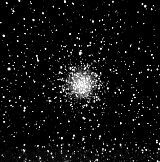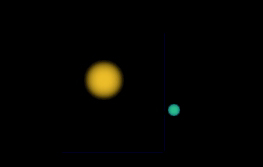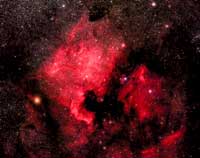The Night Sky July 2011
Compiled by Ian Morison
This page, updated monthly, will let you know some of the things that you can look out for in the night sky. It lists the phases of the Moon, where you will see the naked-eye planets and describes some of the prominent constellations in the night sky during the month.
Image of the Month
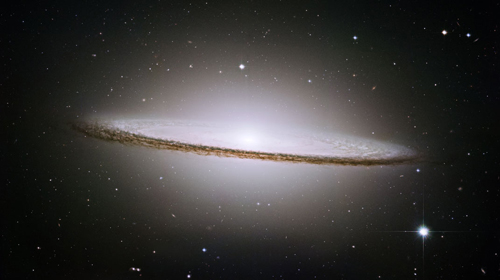
M104, the Sombrero Galaxy
NASA, ESA: Hubble Heritage Team
This is another wonderful image produced by the Hubble Heritage team to leave a lasting legacy of the space telescope's time in space. M104, called the Sombrero galaxy due to its similarity to a sombrero hat, features a very prominent dust lane and a very large extended central bulge containing many globular clusters. As with all large galaxies, it is thought to harbour a super-massive black hole at its heart whose surroundings emit radiation across the whole of the electromagnetic spectrum. At magnitude 9, it is easily seen with a small telescope in the constellation Virgo lying at a distance of ~30 million light years. In the image below, the Spitzer Space Telescope Infrared image has been superimposed on the Hubble image to show the hot regions of gas surrounding young stars in the dust lane.
Highlights of the Month
Early July: Observe Saturn in the evening sky and split a nearby double star, Porrima.
To see some of Damian Peache's Saturn Images: Damian Peache's website
Saturn can still be seen in the western sky after sunset. It lies in the constellation Virgo close to the star Porrima, Gamma Virginis. As Saturn reached the end of its retrograde motion on June 10th, just 15 arc minutes separated them, but now the separation is increasing. The rings are now ~7.5 degrees from the line of site and so Saturn appears brighter than for a couple of years, but it will not be until 2016 that they will be at their widest again. The outer A-ring and slightly brighter B (bright?) ring are separated by a dark band called the Cassini Division. A faint and elusive C (Crepe) ring between the B ring and Saturn's surface. A small telescope will easily show its largest moon, Titan, and show some bands around the surface. See further details below in the "Planets" section. Having viewed Saturn with a small telescope, move just a little to the right to see if you can split the double star Gamma Virginis. Porrima is made up of two identical stars, each of magnitude 3.5. Back in 1919, there were separated by 6 arc seconds, so could easily be split in a small telescope, but around 2005 (at periastron) the pair were so close that they could barely be split, but now they are opening out again and, this summer, should be separated by ~1.7 arc seconds. This means that with good seeing a small telescope should be able to split them again - so why not try? [Note:- Under perfect seeing conditions on June 19th, the author's 4 inch apo refactor showed them as two overlapping diffraction patterns both having a central disk surrounded by concentric rings - so it is possible!]
July around midnight: Spot Brochi's Cluster and the double star Albireo in Cygnus.
By midnight (BST) this month, the constellations Cygnus, Lyra and Aquila will have risen well up inot the south-east. Their three brightest stars Deneb, Vega and Altair respectivly make up the "Summer Triangle". If you sweep with binoculars one third of the way from Altair towards Vega, you should spot Brocchi's Cluster usually called "The Coathanger" as this is exactly what it looks like - but seen upside down. Its not thought to be a real cluster but an "asterism" which is a chance grouping of stars. Not far to the upper left of Brochi's cluster is, perhaps, the most beautiful double star to observe in a small telescope. It is the star Albireo which forms the head of the swan. At magnitude 3 it is the least brightest of the stars that make up a part of Cygnus called the "Northern Cross". However, when seen through a small telescope, it is seen to be made up of two stars showing a beautiful colour contrast. The brighter 3.1 magnitude component (which is itself a double star) is amber in colour whilst the 5.1 magnitude companion star is blue-green in colour. With a separation of 35 arc seconds the pair can be easily split even under poor seeing conditions - in contrast to Porrima above.
Dawn July 27th: A thin Crescent Moon, Jupiter and Mars in the pre-dawn sky
Looking East-Southeast around 40 minutes before sunrise on the morning of July 27th and given a good low horizon in that direction you will see, if clear, a very thin crescent Moon to the right of the planet Mars, shining at magnitude +1.4 but low above the horizon. Jupiter, at -2.4, lies well up and to the right of the Moon. The Pleiades Cluster and Hyades clusters may also be seen in ths very nice skyscape.
July 10th: Two Great Lunar Craters
Two great Lunar Craters: Tycho and Copernicus
This is a great night to observe two of the greatest craters on the Moon, Tycho and Copernicus, as the terminator is nearby. Tycho is towards the bottom of Moon in a densely cratered area called the Southern Lunar Highlands. It is a relatively young crater which is about 108 million years old. It is interesting in that it is thought to have been formed by the impact of one of the remnents of an asteroid that gave rise to the asteroid Baptistina. Another asteroid originating from the same breakup may well have caused the Chicxulub crater 65 million years ago. It has a diameter of 85 km and is nearly 5 km deep. At full Moon - seen in the image below - the rays of material that were ejected when it was formed can be see arcing across the surface. Copernicus is about 800 million years old and lies in the eastern Oceanus Procellarum beyond the end of the Apennine Mountains. It is 93 km wide and nearly 4 km deep and is a clasic "terraced" crater. Both can be seen with binoculars.
Early July: A very good time to spot Noctilucent Clouds!
Noctilucent clouds, also known as polar mesospheric clouds, are most commonly seen in the deep twilight towards the north from our latitude. They are the highest clouds in the atmosphere at heights of around 80 km or 50 miles. Normally too faint to be seen, they are visible when illuminated by sunlight from below the northern horizon whilst the lower parts of the atmosphere are in shadow. They are not fully understood and are increaing in frequencey, brightness and extent; some think that this might be due to climate change! So on a clear dark night as light is draining from the north western sky long after sunset take a look towards the north and you might just spot them!
A Messier Object imaged with the Faulkes Telescope: M1, The Crab Nebula
M1, the Crab Nebula, imaged by Nik Szymanek.
This image was taken using the Faulkes Telescope North by Nik Szymanek - one of the UK's leading astro-photograpers. M1, the first entry in Charles Messier's catalogue, is a supernova in the constellation Taurus. It was seen to explode in 1054 and the remnants of the giant progenitor star have been expanding ever since. It remains visible (as a white smudge of light seen in a small telescope) due to the presence of a neutron star, just 20 km across, that was formed from the star's core at the time of the explosion. The neutron star is spinning at a rate of ~30 times a second, and its intense magnetic field is producing two beams of radiation that sweep round the sky like a lighthouse. The "flashes" of light and radio waves are seen as a very regular train of pulses, hence the name "Pulsar" also given to this object. The visible light pulses integrated over the time of the exposure give rise to a "star-like" image which appears as the lower right "star" of the pair in the centre of the image.
Learn more about the Faulkes Telescopes and how schools can use them: Faulkes Telescope"
Observe the International Space Station
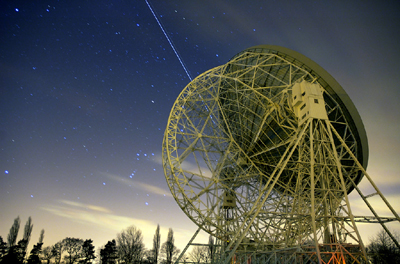
The International Space Station and Jules Verne passing behind the Lovell Telescope on April 1st 2008.
Image by Andrew Greenwood
Use the link below to find when the space station will be visible in the next few days. In general, the space station can be seen either in the hour or so before dawn or the hour or so after sunset - this is because it is dark and yet the Sun is not too far below the horizon so that it can light up the space station. As the orbit only just gets up the the latitude of the UK it will usually be seen to the south, and is only visible for a minute or so at each sighting. Note that as it is in low-earth orbit the sighting details vary quite considerably across the UK. The NASA website linked to below gives details for several cities in the UK. (Across the world too for foreign visitors to this web page.)
Note: I observed the ISS three times recently and was amazed as to how bright it has become.
Find details of sighting possibilities from your location from: Location Index
See where the space station is now: Current Position
The Moon
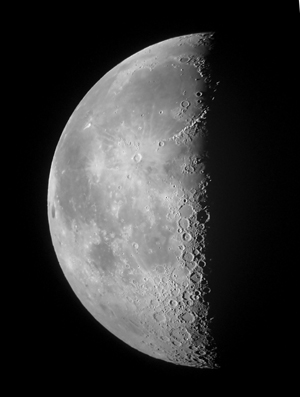
The Moon at 3rd Quarter. Image, by Ian Morison, taken with a 150mm Maksutov-Newtonian and Canon G7.
Just below the crator Plato seen near the top of the image is the mountain "Mons Piton". It casts a long shadow across the maria from which one can calculate its height - about 6800ft or 2250m.
| new moon | first quarter | full moon | last quarter |
|---|---|---|---|
| July 1st | July 8th | July 15th | July 23rd |
Some Lunar Images by Ian Morison, Jodrell Bank Observatory: Lunar Images
A World Record Lunar Image
To mark International Year of Astronomy, a team of British astronomers have made the largest lunar image in history and gained a place in the Guinness Book of Records! The whole image comprises 87.4 megapixels with a Moon diameter of 9550 pixels. This allows details as small as 1km across to be discerned! The superb quality of the image is shown by the detail below of Plato and the Alpine Valley. Craterlets are seen on the floor of Plato and the rille along the centre of the Alpine valley is clearly visible. The image quality is staggering! The team of Damian Peach, Pete lawrence, Dave Tyler, Bruce Kingsley, Nick Smith, Nick Howes, Trevor Little, David Mason, Mark and Lee Irvine with technical support from Ninian Boyle captured the video sequences from which 288 individual mozaic panes were produced. These were then stitched together to form the lunar image.
Please follow the link to the Lunar World Record website and it would be really great if you could donate to Sir Patrick Moore's chosen charity to either download a full resolution image or purchase a print.
The Planets
Jupiter
Jupiter is now well risen in the pre-dawn object and by the end of July will rise at midnight and will have an elevation of 50 degrees at dawn. Its magnitude will will slightly increase from -2.3 to -2.4 during the month and it will have an angular size increasing to ~40 arc seconds by month's end. It is now well worth observing (if you do not mind getting up early!) and a small telescope will easily show the equatorial bands and the Galilean moons. In contrast to Saturn which is moving towards the lower part of the ecliptic (and hence will not reach as high an elevation when due south), Jupiter, now in Aries, is moving towards the higher part of the ecliptic and so, in the next few years, will be a superb object to observe.
See Highlight above.Saturn
Saturn. At the beginning of July, Saturn is still just visible low (at an elevation of ~16 degrees) in the Southwest after sunset, but by month's end it will be barely visible, at just 12 degreees elevation above the horizon, as darkness falls. It has a magnitude of +0.9 throughout the month. Compared to early last year, its apparent brightness has now increased as the rings have opened out again - now tilted at +8 degrees from edge on. The plus sign indicates that we are seeing Saturn's north pole. The rings span an angular size of ~35 arc seconds - over double the 17 arc seconds of the planet's disk. Given a small telescope it may just be be possible (given the low altitude) to see Cassini's division - a dark band that separates the A and B rings. It will also show Saturn's brightest moon, Titan, (at magnitude +8) and, given good conditions, other moons as well.
Mercury
Mercury will be just visible above the north-western horizon throughout the month with a magnitude reducing from -0.2 down to +0.7. It reaches greatest elongation from the Sun on the 20th July when it will have an elevation of 8 degrees at sunset. Perhaps see where the Sun sets on the horizon and look in the same direction with binoculars about 45 minutes later.
Mars
Mars is now visible in the pre-dawn sky but again, as the ecliptic is at a shallow angle to the horizon, its elevation will not be very high. To spot it, a good, low, eastern horizon and, quite probably, a pair of binoculars will be needed. This month, its magnitude remains at +1.4 and its angular size will be touch over 4 arc seconds. By month's end it will be 40 degrees west of the Sun and have an elevation of ~29 degrees at sunrise lying in the constellation Taurus close to its boundary with Gemini. With an angular size of just over 4 arc seconds, the salmon pink disk is unlikely to show any detail - but as the months go by it angular size will increase, so be patient.
See Highlight above.
Venus
Venus passes behind the Sun on the 15th of August and so will not really be visible for a few weeks. It might just be glimpsed just before dawn low above the horizon in the East-Northeast at the beginning of the month with a magnitude of -3.9 and a virtually fully illuminated 10 arc second disk.
See Highlight above.
Find more planetary images and details about the Solar System: The Solar System
The Stars
The late evening July Sky
This map shows the constellations seen towards the south at about 10pm BST in mid July. The most prominent star, just a little west of South, is Arcturus in Bootes. It is the second (after Sirius) brightest star in the northern sky. High overhead towards the north (not shown on the chart) and up to the right of Arcturus lies Ursa Major with its prominent grouping of the Plough. As one moves southwards to the left of Bootes one first crosses the constellation Hercules with its magnificent globular cluster, M13, and then across the large but not prominent constellation Ophiucus until, low above the southern horizon lie Sagittarius and Scorpius. Those in the south of the UK - and even better in Southern Europe - will spot the bright red star Antares. Rising in the east is the beautiful region of the Milky Way containing both Cygnus and Lyra. Below is Aquilla. The three bright stars Deneb (in Cygnus), Vega (in Lyra) and Altair (in Aquila) make up the "Summer Triangle".
The constellation Ursa Major
The stars of the Plough, shown linked by the thicker lines in the chart above, form one of the most recognised star patterns in the sky. Also called the Big Dipper, after the soup ladles used by farmer's wives in America to serve soup to the farm workers at lunchtime, it forms part of the Great Bear constellation - not quite so easy to make out! The stars Merak and Dubhe form the pointers which will lead you to the Pole Star, and hence find North. The stars Alcor and Mizar form a naked eye double which repays observation in a small telescope as Mizar is then shown to be an easily resolved double star. A fainter reddish star forms a triangle with Alcor and Mizar.
Ursa Major contains many interesting "deep sky" objects. The brightest, listed in Messier's Catalogue, are shown on the chart, but there are many fainter galaxies in the region too. In the upper right of the constellation are a pair of interacting galaxies M81 and M82 shown in the image below. M82 is undergoing a major burst of star formation and hence called a "starburst galaxy". They can be seen together using a low power eyepiece on a small telescope.
Another, and very beautiful, galaxy is M101 which looks rather like a pinwheel firework, hence its other name the Pinwheel Galaxy. It was discovered in1781 and was a late entry to Messier's calalogue of nebulous objects. It is a type Sc spiral galaxy seen face on which is at a distance of about 24 million light years. Type Sc galaxies have a relativly small nucleus and open spiral arms. With an overall diameter of 170,000 light it is one of the largest spirals known (the Milky Way has a diameter of ~ 130,000 light years).
Though just outside the constellation boundary, M51 lies close to Alkaid, the leftmost star of the Plough. Also called the Whirlpool Galaxy it is being deformed by the passage of the smaller galaxy on the left. This is now gravitationally captured by M51 and the two will eventually merge. M51 lies at a distance of about 37 million light years and was the first galaxy in which spiral arms were seen. It was discovered by Charles Messier in 1773 and the spiral structure was observed by Lord Rosse in 1845 using the 72" reflector at Birr Castle in Ireland - for many years the largest telescope in the world.
Lying close to Merak is the planetary nebula M97 which is usually called the Owl Nebula due to its resemblance to an owl's face with two large eyes. It was first called this by Lord Rosse who drew it in 1848 - as shown in the image below right. Planetary nebulae ar the remnants of stars similar in size to our Sun. When all possible nuclear fusion processes are complete, the central core collpses down into a "white dwarf" star and the the outer parts of the star are blown off to form the surrounding nebula.
The constellation Hercules
Between the constellation Bootes and the bright star Vega in Lyra lies the constellation Hercules.The Red Giant star Alpha Herculis or Ras Algethi, its arabic name, is one of the largest stars known, with a diameter of around 500 times that of our Sun. In common with most giant stars it varies its size, changing in brightness as it does so from 3rd to 4th magnitude. Lying along one side of the "keystone" lies one of the wonders of the skies, the great globular cluster, M13. Just visible to the unaided eye on a dark clear night, it is easily seen through binoculars as a small ball of cotten wool about 1/3 the diameter of the full Moon. The brightness increases towards the centre where the concentration of stars is greatest. It is a most beautiful sight in a small telescope. It contains around 300,000 stars in a region of space 100 light years across, and is the brightest globular cluster that can be seen in the northern hemisphere.
The constellation Virgo
Virgo, in the south-east after sunset this month, is not one of the most prominent constellations, containing only one bright star, Spica, but is one of the largest and is very rewarding for those with "rich field" telescopes capable of seeing the many galaxies that lie within its boundaries. Spica is, in fact, an exceedingly close double star with the two B type stars orbiting each other every 4 days. Their total luminosity is 2000 times that of our Sun. In the upper right hand quadrant of Virgo lies the centre of the Virgo Cluster of galaxies. There are 13 galaxies in the Messier catalogue in this region, all of which can be seen with a small telescope. The brightest is the giant elliptical galaxy, M87, with a jet extending from its centre where there is almost certainly a massive black hole into which dust and gas are falling. This releases great amounts of energy which powers particles to reach speeds close to the speed of light forming the jet we see. M87 is also called VIRGO A as it is a very strong radio source.
Below Porrima and to the right of Spica lies M104, an 8th magnitude spiral galaxy about 30 million light years away from us. Its spiral arms are edge on to us so in a small telescope it appears as an elliptical galaxy. It is also known as the Sombrero Galaxy as it looks like a wide brimmed hat in long exposure photographs.
The constellations Lyra and Cygnus
This month the constellations Lyra and Cygnus are rising in the East as darkness falls with their bright stars Vega, in Lyra, and Deneb, in Cygnus, making up the "summer triangle" of bright stars with Altair in the constellation Aquila below. (see sky chart above)
Lyra
Lyra is dominated by its brightest star Vega, the fifth brightest star in the sky. It is a blue-white star having a magnitude of 0.03, and lies 26 light years away. It weighs three times more than the Sun and is about 50 times brighter. It is thus burning up its nuclear fuel at a greater rate than the Sun and so will shine for a correspondingly shorter time. Vega is much younger than the Sun, perhaps only a few hundred million years old, and is surrounded by a cold,dark disc of dust in which an embryonic solar system is being formed!
There is a lovely double star called Epsilon Lyrae up and to the left of Vega. A pair of binoculars will show them up easily - you might even see them both with your unaided eye. In fact a telescope, provided the atmosphere is calm, shows that each of the two stars that you can see is a double star as well so it is called the double double!
Between Beta and Gamma Lyra lies a beautiful object called the Ring Nebula. It is the 57th object in the Messier Catalogue and so is also called M57. Such objects are called planetary nebulae as in a telescope they show a disc, rather like a planet. But in fact they are the remnants of stars, similar to our Sun, that have come to the end of their life and have blown off a shell of dust and gas around them. The Ring Nebula looks like a greenish smoke ring in a small telescope, but is not as impressive as it is shown in photographs in which you can also see the faint central "white dwarf" star which is the core of the original star which has collapsed down to about the size of the Earth. Still very hot this shines with a blue-white colour, but is cooling down and will eventually become dark and invisible - a "black dwarf"! Do click on the image below to see the large version - its wonderful!
M56 is an 8th magnitude Globular Cluster visible in binoculars roughly half way between Alberio (the head of the Swan) and Gamma Lyrae. It is 33,000 light years away and has a diameter of about 60 light years. It was first seen by Charles Messier in 1779 and became the 56th entry into his catalogue.
Cygnus
Cygnus, the Swan, is sometimes called the "Northern Cross" as it has a distinctive cross shape, but we normally think of it as a flying Swan. Deneb,the arabic word for "tail", is a 1.3 magnitude star which marks the tail of the swan. It is nearly 2000 light years away and appears so bright only because it gives out around 80,000 times as much light as our Sun. In fact if Deneb where as close as the brightest star in the northern sky, Sirius, it would appear as brilliant as the half moon and the sky would never be really dark when it was above the horizon!
The star, Albireo, which marks the head of the Swan is much fainter, but a beautiful sight in a small telescope. This shows that Albireo is made of two stars, amber and blue-green, which provide a wonderful colour contrast. With magnitudes 3.1 and 5.1 they are regarded as the most beautiful double star that can be seen in the sky.
Cygnus lies along the line of the Milky Way, the disk of our own Galaxy, and provides a wealth of stars and clusters to observe. Just to the left of the line joining Deneb and Sadr, the star at the centre of the outstretched wings, you may, under very clear dark skys, see a region which is darker than the surroundings. This is called the Cygnus Rift and is caused by the obscuration of light from distant stars by a lane of dust in our local spiral arm. the dust comes from elements such as carbon which have been built up in stars and ejected into space in explosions that give rise to objects such as the planetary nebula M57 described above.
Deneb,the arabic word for "tail", is a 1.3 magnitude star which marks the tail of the swan. It is nearly 2000 light years away and appears so bright only because it gives out around 80,000 times as much light as our Sun. In fact if Deneb where as close as the brightest star in the northern sky, Sirius, it would appear as brilliant as the half moon and the sky would never be really dark when it was above the horizon!
There is a beautiful region of nebulosity up and to the left of Deneb which is visible with binoculars in a very dark and clear sky. Photographs show an outline that looks like North America - hence its name the North America Nebula. Just to its right is a less bright region that looks like a Pelican, with a long beak and dark eye, so not surprisingly this is called the Pelican Nebula. The photograph below shows them well.
Brocchi's Cluster An easy object to spot with binoculars in Gygnus is "Brocchi's Cluster", often called "The Coathanger",although it appears upside down in the sky! Follow down the neck of the swan to the star Alberio, then sweep down and to its lower left. You should easily spot it against the dark dust lane behind.

